- Home
- About
- Map
- Trips
- Bringing Boat West
- Migration West
- Solo Motorcycle Ride
- Final Family XC Trip
- Colorado Rockies
- Graduates' XC Trip
- Yosemite & Nevada
- Colorado & Utah
- Best of Utah
- Southern Loop
- Pacific Northwest
- Northern Loop
- Los Angeles to NYC
- East Coast Trips
- Martha's Vineyard
- 1 Week in Quebec
- Southeast Coast
- NH Backpacking
- Martha's Vineyard
- Canadian Maritimes
- Ocracoke Island
- Edisto Island
- First Landing '02
- Hunting Island '02
- Stowe in Winter
- Hunting Island '01
- Lake Placid
- Chesapeake
- Provincetown
- Hunting Island '00
- Acadia in Winter
- Boston Suburbs
- Niagara Falls
- First Landing '99
- Cape Hatteras
- West Coast Trips
- Burning Man
- Utah Off-Roading
- Maui
- Mojave 4WD Course
- Colorado River Rafting
- Bishop & Death Valley
- Kauai
- Yosemite Fall
- Utah Off-Road
- Lost Coast
- Yosemite Valley
- Arizona and New Mexico
- Pescadero & Capitola
- Bishop & Death Valley
- San Diego, Anza Borrego, Joshua Tree
- Carmel
- Death Valley in Fall
- Yosemite in the Fall
- Pacific Northwest
- Utah Off-Roading
- Southern CA Deserts
- Yosemite & Covid
- Lake Powell Covid
- Eastern Sierra & Covid
- Bishop & Death Valley
- Central & SE Oregon
- Mojave Road
- Eastern Sierra
- Trinity Alps
- Tuolumne Meadows
- Lake Powell Boating
- Eastern Sierra
- Yosemite Winter
- Hawaii
- 4WD Eastern Sierra
- 4WD Death Valley +
- Southern CA Deserts
- Christmas in Tahoe
- Yosemite & Pinnacles
- Totality
- Yosemite & Sierra
- Yosemite Christmas
- Yosemite, San Diego
- Yosemite & North CA
- Seattle to Sierra
- Southwest Deserts
- Yosemite & Sierra
- Pacific Northwest
- Yosemite & South CA
- Pacific Northwest
- Northern California
- Southern Alaska
- Vancouver Island
- International Trips
- Index
- Tips
- Books
- Photos/Videos
- Search
- Contact
Mulege, Mexico
Sunday, February 24, 2019 - 7:00pm by Lolo
41 miles and 1 hour from our last stop - 1 night stay
Travelogue
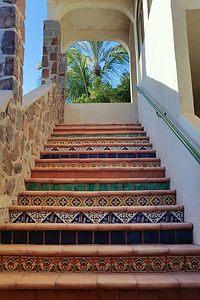 Tiled steps of Hotel Casa GranadaDuring my somewhat overly-cautious, pre-trip planning phase, I had booked two nights at Casa Granada Hotel in Mulege, because it was located at the mouth of the Bay of Concepcion, where the beaches were said to be fabulous. From the photos the hotel looked very nice, especially for $55 per night.
Tiled steps of Hotel Casa GranadaDuring my somewhat overly-cautious, pre-trip planning phase, I had booked two nights at Casa Granada Hotel in Mulege, because it was located at the mouth of the Bay of Concepcion, where the beaches were said to be fabulous. From the photos the hotel looked very nice, especially for $55 per night.
However, when our Baji expert friends in Kuyima were giving us tips and advice, they said that the town of Loreto was absolutely beautiful, but Mulege was kind of gritty. Hmm..Gritty was not exactly what I was looking for, so we decided to change our stay to one night and then drive further south to Loreto to spend more time. In retrospect, this was absolutely the right thing to do.
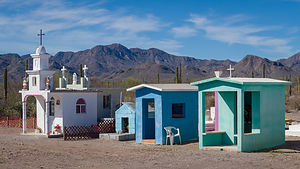 Roadside cemetery on the road to MulegeOn our drive down 1 to Mulege from Santa Rosalia, we passed a series of colorful buildings on the right, many of them with crosses and angels on their roofs. Wanting to see what they were, we made a U-turn and pulled into an unmarked dirt driveway. It turned out to be a cemetery and each of those small, colorful buildings was mausoleum. Set against a backdrop of cacti and mountains, it was a lovely, peaceful setting for families to visit their past loved ones. Each of the mausoleums contained photos, flowers, and various memorabilia associated with the deceased. These were obviously the graves of wealthy people, as their dwellings were far nicer than those for many of the living in northern Baja.
Roadside cemetery on the road to MulegeOn our drive down 1 to Mulege from Santa Rosalia, we passed a series of colorful buildings on the right, many of them with crosses and angels on their roofs. Wanting to see what they were, we made a U-turn and pulled into an unmarked dirt driveway. It turned out to be a cemetery and each of those small, colorful buildings was mausoleum. Set against a backdrop of cacti and mountains, it was a lovely, peaceful setting for families to visit their past loved ones. Each of the mausoleums contained photos, flowers, and various memorabilia associated with the deceased. These were obviously the graves of wealthy people, as their dwellings were far nicer than those for many of the living in northern Baja.
Rather than go directly to our hotel, which was located on the far side of the Rio Santa Rosalia de Mulege (Mulege River), which ran through town, we decided to stop first at the two historical sites mentioned in the Moon Baja guidebook.
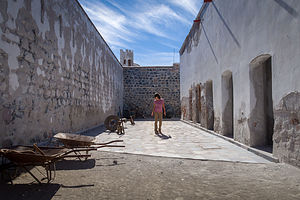 Museo Historico de MulegeOur first stop was the Museo Historico de Mulege, a one-time prison turned into a museum. In its day, the prison had quite a unique detention policy in that prisoners were allowed to leave during the day to work in town, but had to return to their cells by 6 pm each evening. Just in case they didn’t have watches, a conch shell was blown to inform them it was time to come back. There wasn’t much concern about anyone escaping, because before the Transpeninsular Highway (Mexico 1) was built in the 1970s, you couldn’t get too far from Mulege. Sort of the same theory for the placement of Japanese internment camps in the U.S.
Museo Historico de MulegeOur first stop was the Museo Historico de Mulege, a one-time prison turned into a museum. In its day, the prison had quite a unique detention policy in that prisoners were allowed to leave during the day to work in town, but had to return to their cells by 6 pm each evening. Just in case they didn’t have watches, a conch shell was blown to inform them it was time to come back. There wasn’t much concern about anyone escaping, because before the Transpeninsular Highway (Mexico 1) was built in the 1970s, you couldn’t get too far from Mulege. Sort of the same theory for the placement of Japanese internment camps in the U.S.
Today the museum houses an eclectic collection of historical artifacts - farm implements, typewriters, an old bomb, a colorful fake T-Rex, and much more.
 Mision Santa Rosalia de MulegeAfter the museum we drove over to the Mision Santa Rosalia de Mulege. It seemed that every decent-sized town had one. I assume the missions came first, and then the towns built up around them. Still, Baja had several missions that could only be reach via bumpy dirt roads.
Mision Santa Rosalia de MulegeAfter the museum we drove over to the Mision Santa Rosalia de Mulege. It seemed that every decent-sized town had one. I assume the missions came first, and then the towns built up around them. Still, Baja had several missions that could only be reach via bumpy dirt roads.
This particular mission was founded by a Jesuit priest named Padre Manuel de Basaldua, as a settlement for the local Cochimi natives, who he hoped to convert to Catholicism. When it was built in 1766, the Mision Santa Rosalia de Mulege became the fourth mission in Baja. This was the first mission that we were not able to enter because the doors were locked - and it was a Sunday. We assumed that perhaps there was an upcoming wedding, as there were wedding decorations on the door.
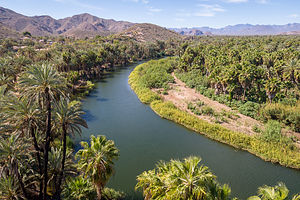 Rio Santa Rosalia de MulegeBehind the mission, we climbed up the steps of a rocky viewpoint and looked down at the lush and palm-lined Rio Santa Rosalia de Mulege flowing beneath us. It had a very different feel from the desert terrain we had been driving through for days.
Rio Santa Rosalia de MulegeBehind the mission, we climbed up the steps of a rocky viewpoint and looked down at the lush and palm-lined Rio Santa Rosalia de Mulege flowing beneath us. It had a very different feel from the desert terrain we had been driving through for days.
Now that we had knocked off Mulege’s two major sites, we headed over to the Casa Granada, our home for the night. Their website photos didn’t lie. It really was lovely.
There was still a lot of time left to the day, so we took a drive down Mexico 1 to check out Playa Santispac, a very popular beach for camping on the Bahia Concepcion, especially so because it has a restaurant. It certainly was popular. There were large motorhomes lined up 10 feet apart all the way along the shoreline - not exactly our cup of tea. Also, the wind was so strong that camping in a tent would have been very unpleasant.
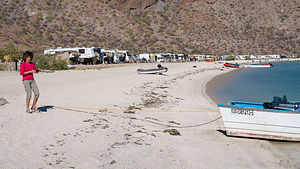 Windy Playa SantispacWe spoke for awhile with a girl from Colorado, who was sitting on the lee side of her truck with her dogs to get some protection from the wind. She said she had been coming to Baja since she was a kid and absolutely loved it. She had to go back to the States in a few days, but said she wanted to stay here 6 months next year. I have to say that I don’t get it. I guess we are not the types that are able to just chill for that long a time. We need to be moving - seeing new things and especially being active. To each his own.
Windy Playa SantispacWe spoke for awhile with a girl from Colorado, who was sitting on the lee side of her truck with her dogs to get some protection from the wind. She said she had been coming to Baja since she was a kid and absolutely loved it. She had to go back to the States in a few days, but said she wanted to stay here 6 months next year. I have to say that I don’t get it. I guess we are not the types that are able to just chill for that long a time. We need to be moving - seeing new things and especially being active. To each his own.
Afterwards, we decided to check out the beach by our hotel. It was still very windy and the beach was not particularly pretty. However, there was a view of the lighthouse across the river, and we had fun watching a mother and her two kids digging around in the sand near the water’s edge. Before long, one of kids picked up something big enough to require two hands. They all gathered around as mom went to work on it and soon handed them something that they put in their mouths. Not being aficionados of raw shellfish of any sort, as Herb is highly allergic, I assume that was the prize.
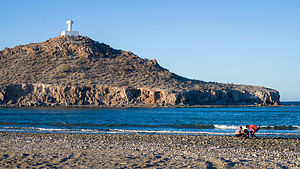 Mulege lighthouseThat evening for the first time we did not have a restaurant in our hotel. We looked on TripAdvisor and found the La Serenidad Hotel next door had a very highly-reviewed restaurant. They were especially known for their Saturday night pig roasts, but since it was Sunday we would have to order off the menu.
Mulege lighthouseThat evening for the first time we did not have a restaurant in our hotel. We looked on TripAdvisor and found the La Serenidad Hotel next door had a very highly-reviewed restaurant. They were especially known for their Saturday night pig roasts, but since it was Sunday we would have to order off the menu.
The place did not look too impressive from the outside. In fact, it was surrounded on all four sides by a wall, making it appear like a military compound. We finally found the opening and were surprised how nice things were behind those walls - lovely pool where you could swim up to a bar, cozy restaurant with a fireplace, etc.
We got a table by the fireplace and had a delicious dinner . I had the fish tacos and Herb, once again, the chile relleno - he really needs to venture out a bit. Perhaps raw fish on the beach?
Description
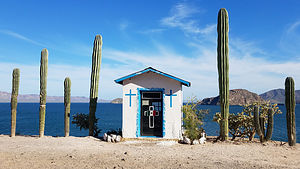 Roadside memorialMulege is a small colonial town located at the opening of the Bahia Concepcion on the Sea of Cortez. Unlike the desert topography of the north, Mulege is a lush green oasis with palm trees, with the Rio Santa Rosalia de Mulege (Mulege River) running through before meeting up with the Sea of Cortez. In fact, “Mulege” is the Cochimi word for “large sandbar of the white mouth”.
Roadside memorialMulege is a small colonial town located at the opening of the Bahia Concepcion on the Sea of Cortez. Unlike the desert topography of the north, Mulege is a lush green oasis with palm trees, with the Rio Santa Rosalia de Mulege (Mulege River) running through before meeting up with the Sea of Cortez. In fact, “Mulege” is the Cochimi word for “large sandbar of the white mouth”.
In 1705, a Jesuit priest named Padre Manuel de Basaldua traveled north from Loreto to found a settlement for the local Cochimi natives. When it was built in 1766, the Mision Santa Rosalia de Mulege became the fourth mission in Baja. To visit this lovely stone church, follow Calle Zaragoza west up a slight hill.
Another place of historical interest is the Museo Historico de Mulege, a one-time prison turned into a museum. In its day, the prison was quite unique in its policy of allowing prisoners to leave during the day to work in town. 6 pm each evening, they were called back to their cells by the blowing of a conch cell. There wasn’t much concern about anyone escaping, because before the Transpeninsular Highway (Mexico 1) was built in the 1970s, you couldn’t get too far. Today the museum houses an eclectic collection of historical artifacts.
- ‹ previous
- 7 of 14
- next ›
Mulege location map in "high definition"
Javascript is required to view this map.
